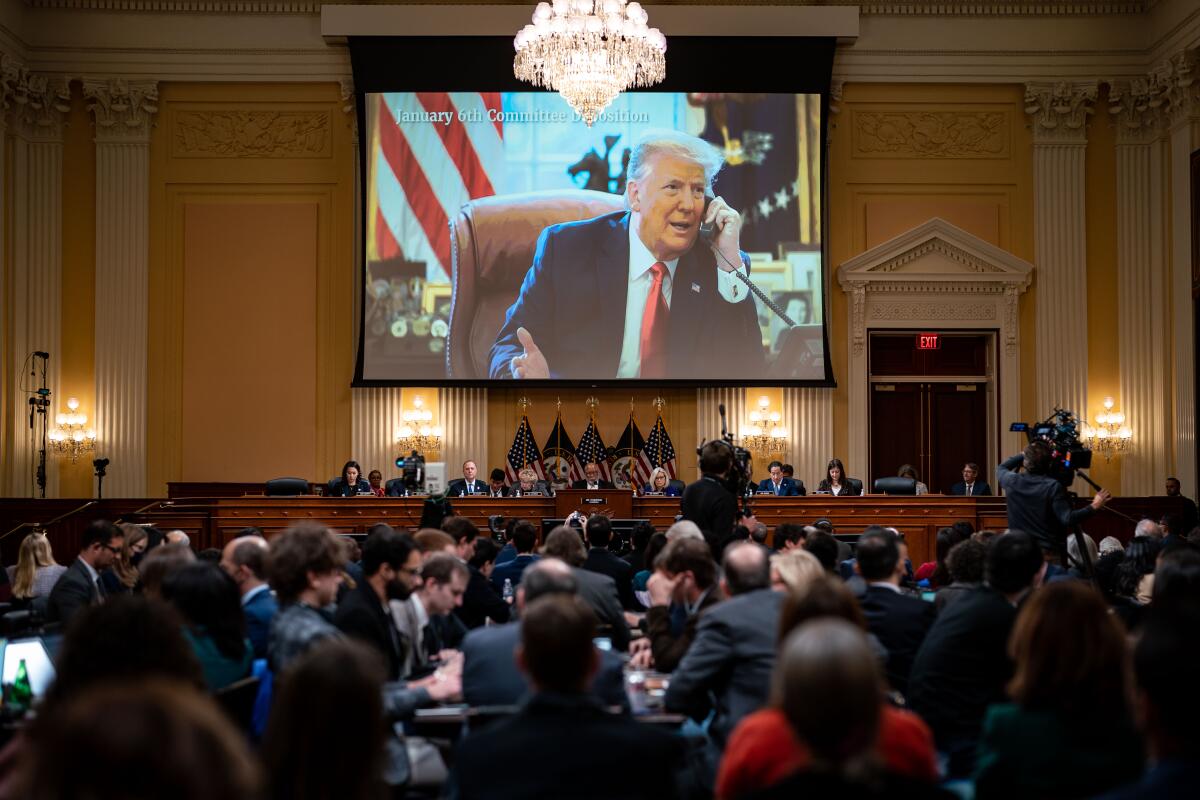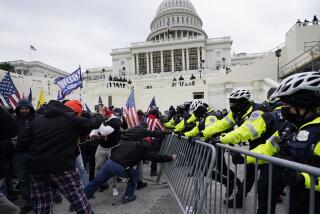Landmark Jan. 6 report concludes Trump intentionally misled and provoked insurrectionists

- Share via
WASHINGTON — The highest-profile congressional investigation since Watergate concluded Thursday that former President Trump intentionally spread false claims about the 2020 election and provoked a mob of his supporters to attack the U.S. Capitol.
The long-anticipated, 845-page report of eight chapters from the House select committee probing the Jan. 6, 2021, insurrection provides a road map for potential criminal charges against Trump and others.
The long-anticipated 845-page, eight-chapter report from the House select committee investigating the Jan. 6, 2021, insurrection provides a road map for potential criminal charges against Trump and others.
Written in a narrative style, rather than the dry, bureaucratic tone that characterizes most investigative reports of this magnitude, the document elaborates on the story the committee laid out in its televised hearings earlier this year, detailing “a multipart plan to overturn the 2020 presidential election” and blaming the insurrection ultimately on “one man.”
The committee voted Monday to refer its findings to the Justice Department for possible prosecution. The panel recommended four federal charges against Trump, including assisting, aiding or comforting those involved in an insurrection.
The Justice Department is conducting its own investigation into the Jan. 6 attack, which left five people dead.
“As you read this report, please consider this: Vice President Pence, along with many of the appointed officials who surrounded Donald Trump, worked to defeat many of the worst parts of Trump’s plan to overturn the election,” committee Vice Chair Liz Cheney (R-Wyo.) wrote in the foreword to the report. “This was not a certainty. It is comforting to assume that the institutions of our Republic will always withstand those who try to defeat our Constitution from within. But our institutions are only strong when those who hold office are faithful to our Constitution.”
In a post on his Truth Social platform late Thursday, Trump responded that the committee had intentionally misconstrued what happened. He falsely blamed House Speaker Nancy Pelosi (D-San Francisco) for the violence on Jan. 6.
“The highly partisan Unselect Committee Report purposely fails to mention the failure of Pelosi to heed my recommendation for troops to be used in D.C., show the ‘Peacefully and Patrioticly’ words I used, or study the reason for the protest, Election Fraud. WITCH HUNT!” he wrote.
The report begins by describing the weeks leading up to the election and detailing evidence that Trump intended to declare victory on election night regardless of what the results showed.
Stephen K. Bannon, who had served as Trump’s 2016 campaign manager, previewed that plan on Oct. 31, 2020, telling a private audience that Trump would take advantage of the way Americans vote to “declare himself a winner.” More Democrats vote by mail than Republicans, all but ensuring that Trump would appear to lead before all the votes were tallied.
The report also documents Trump and his allies’ efforts to reverse his loss to Joe Biden, detailing their many court cases and appeals to state lawmakers.
The committee estimates that Trump and his team reached out to state legislators or election officials at least 200 separate times in both public and private. Trump held a meeting with “nearly 300 state legislators from battleground states” in which he “urged them to exercise what he called ‘the real power’ to choose electoral votes before Jan. 6,” the committee found.
In Arizona, Trump and his lawyer Rudolph W. Giuliani tried to pressure Arizona state House Speaker Russell Bowers into holding a public hearing with the goal of replacing the state’s electors with loyalists who would cast votes for Trump.
“You are asking me to do something against my oath, and I will not break my oath,” Bowers said.
Giuliani replied: “Aren’t we all Republicans here? I mean, I would think you would listen a little more open to my suggestions.”
The report highlights Trump allies’ campaign to pressure Department of Justice officials to declare, without evidence, that the election was being stolen.
That effort culminated when Trump threatened to replace Jeffrey Rosen, the acting attorney general, who had refused to sign a factually incorrect letter urging state legislators to examine their election results. Jeffrey Clark, the head of the Justice Department’s civil division, was willing to sign the letter. Trump wanted to give Rosen’s job to Clark, but backed off when even dozens of appointed Justice Department officials threatened to resign.
The document also lays out how Trump and his legal team badgered Vice President Mike Pence with the incorrect theory that he had the power to reject states’ electoral votes. It explains that Pence rejected that theory, reasoning that the Founding Fathers would not have given one politician the power to overturn a national election.
“Over the course of the post-election period, as their other plans each failed, the importance of January 6th and the need to pressure Vice President Pence increased,” the report reads.
Trump and his allies continued to publicly pressure Pence to attempt to block the certification of Biden’s victory, even during the Jan. 6 rally at the Ellipse, triggering chants of “Hang Mike Pence” during the attack on the Capitol.
The report concludes by describing Trump summoning thousands of supporters to Washington with a tweet urging them “be there, will be wild,” whipping them up during his speech at the Ellipse, and then spending 187 minutes sitting in a White House dining room, watching as the mob stormed the Capitol, and ignoring the family members, aides, Republican politicians and media figures who urged him to intervene.
As the crisis unfolded, Trump continued to tweet, but rebuffed calls to calm the violence. Three hours after the attack had begun, Trump finally made a statement on camera telling the crowd to leave.
“Our country has come too far to allow a defeated president to turn himself into a successful tyrant by upending our democratic institutions, fomenting violence, and, as I saw it, opening the door to those in our country whose hatred and bigotry threaten equality and justice for all Americans,” committee Chairman Bennie Thompson (D-Miss.) wrote in the report’s foreword.
The 18-month investigation collected more than 1,000 depositions, including from many of Trump’s top aides, Cabinet officials and family members, as well as more than 1 million documents.
Thompson said Monday that the bulk of the nonsensitive material compiled by the panel would be made public before the end of the year. Thompson did not say how many documents would be released or what would be deemed sensitive.
The report, which is expected to mark the final act of the bipartisan committee, includes a list of 11 recommendations, including changes to Capitol Police oversight; new protections for election workers; and officially declaring the riot an insurrection so those who participated will be barred from holding office under the Constitution’s 14th Amendment.
The panel has already endorsed overhauling the Electoral Count Act, the law that Trump and his allies tried to exploit in an attempt to cling to power. The House is scheduled to give final approval to that overhaul on Friday.
The document also includes four appendices on topics including the funding behind Trump’s Jan. 6 rally and the intelligence failures that allowed the attack to occur.
Republicans, who take control of the House on Jan. 3, have said they don’t plan to continue the committee’s work. In fact, House Minority Leader Kevin McCarthy (R-Bakersfield), the front-runner to become the next speaker, said Republicans may investigate the workings of the Jan. 6 committee itself. The committee’s recommendations aren’t likely to gain traction under Republican control.
That left the Jan. 6 panel racing to make its report and potentially millions of pages of underlying evidence public in less than two weeks.
That time crunch can be seen throughout the final report, which was released late in the day Thursday. It includes, for example, a reference to the Federal Bureau of Intelligence rather than the Federal Bureau of Investigation. The date of the report’s release is prominently displayed on its cover as “December 00, 2022. But the report nevertheless offers the most comprehensive summary to date of the facts surrounding what led to the events of Jan. 6, 2021.
In a 30-page appendix, the report touches on the failures of intelligence and law enforcement agencies, which generally missed or ignored signs that extremist groups had taken a Dec. 19 tweet from Trump inviting them to Washington on Jan. 6 as a call to organize and prepare for violence. Getting to the root of those intelligence failures was among the primary responsibilities given to the committee when it was created by the House.
“Although some of that intelligence was fragmentary, it should have been sufficient to warrant far more vigorous preparations for the security of the joint session. The failure to sufficiently share and act upon that intelligence jeopardized the lives of the police officers defending the Capitol and everyone in it,” the committee wrote.
The committee blamed the hours-long delay before National Guard troops arrived at the Capitol in part on senior military leaders’ wariness about involving the military in quelling domestic protests.
“Trump’s eagerness to engage the US military to play a visible role in addressing domestic unrest during the late spring and summer of 2020 does appear to have prompted senior military leadership to take precautions, in preparing for the joint session,” the report states. “While the delay seems unnecessary and unacceptable, it was the byproduct of military processes, institutional caution, and a revised deployment approval process.”
Earlier Thursday, the committee released the latest in a series of more than three dozen interview transcripts. The revelations in those documents included details of an apparent pressure campaign by Trump’s allies on one of the committee’s key witnesses, former White House aide Cassidy Hutchinson.
Stefan Passantino, the Trump-aligned lawyer who initially represented Hutchinson, had instructed her to downplay her knowledge of the machinations within the White House, including Meadows’ role in strategizing, and told her not to acknowledge conversations she overheard or was told of or details of what happened during the insurrection, Hutchinson told the committee in two days of depositions in September. Passantino has denied wrongdoing.
Times staff writers Freddy Brewster, Arit John, Kimbriell Kelly and Courtney Subramanian contributed to this report.
More to Read
Get the L.A. Times Politics newsletter
Deeply reported insights into legislation, politics and policy from Sacramento, Washington and beyond. In your inbox three times per week.
You may occasionally receive promotional content from the Los Angeles Times.












